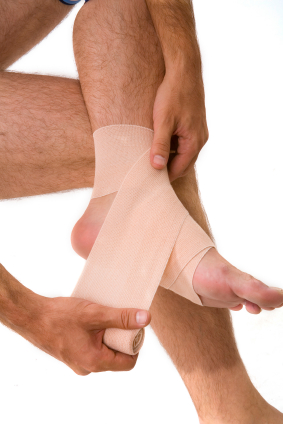Some of the most common injuries treated by PTs are sprains and strains. Although treated similarly they are injuries to different parts of the body.
Sprain: This is an over stretching of a ligament or a joint. Ligaments hold 2 bones together forming a joint. The joint capsule and ligaments that are the support system of a joint. If the joint is over stretched these structures become weakened and lax. These injuries occur when a joint is taken beyond its normal range of motion like rolling an ankle or over reaching with your arm.
Strain: This is an injury to a muscle and or the tendon it is attached to. These types of injuries occur when a force is put on a muscle as it is contracting. Running and jumping and lifting are common causes of strains. This would be an example of an acute strain. Chronic strains occur with overuse of a muscle leading to pain and weakness.
Symptoms: swelling, pain, decreased or increased mobility of the area, muscle spasm, bruising, difficulty walking for leg injuries or reaching, lifting and grasping for arm injuries.
What body parts can sustain these injuries? Any joint or muscle or group of joints and muscles. Often times you have both a sprain and a strain.
These types of injuries are classified by the extent of the damage to the tissues.
- Grade 1 is a minor sprain/strain. There is stretching or very minor tearing of the tissues. These injuries usually heal fairly quickly without need of much intervention. RICE (rest, ice, compression and elevation) will usually be enough to resolve this level injury.
- Grade 2 is moderate over stretching and partial tearing of the tissue. The muscle, ligament or tendon is still able to perform its job but is considerably weaker. These are also treated with RICE but may also benefit from a short period of immobilization to allow the tissue to properly heal. This may mean a sling, a brace or use of crutches to limit impact on the injury.
- Grade 3 is a more significant tearing of tissues leading to gross instability of a joint or loss of muscle function. This injury will definitely require medical attention. Again pending the degree it may result in prolonged immobilization and possible surgical intervention to restore stability and or function.
- Grade 4 would be a complete rupture of the tissue and loss of normal function of a joint or muscle. Again this level of injury is going to require medical attention and surgery to restore function to the joint or muscle.
In Grade 2 or 3 injuries physical therapy may be appropriate. Therapy treatments for these injuries include massage to control swelling and promote appropriate tissue healing, use of various modalities to control pain and instruction in the best excises to retrain the muscle and ligaments to function the way they are supposed to as well as to prevent re injury.
Should you have a more severe injury requiring surgical repair your physical therapist will work to regain motion, slowly stretch the repaired tissues, and provide strengthening and return to activity instructions as well.
Please contact us or your local physical therapist if you need more information or assistance regarding sprains or strains. 401-884-9541 or www.trucarept.com

